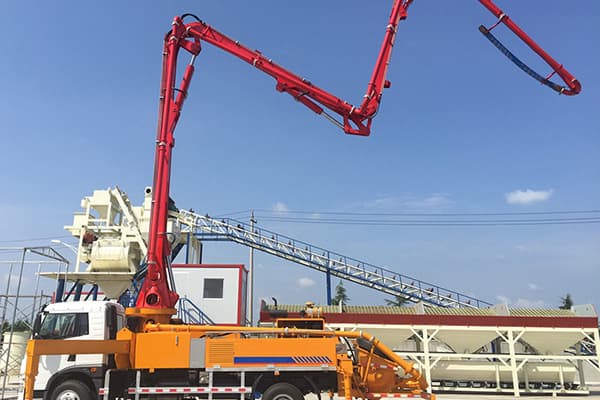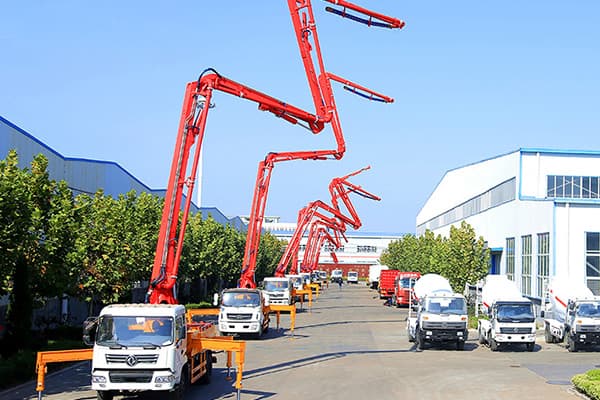How to Operate a Truck-Mounted Concrete Boom Pump Safely
Last Updated: 2025-08-25
Operating a truck-mounted concrete boom pump is a high-stakes task — safety lapses can lead to equipment damage, project delays, or even severe injuries. To mitigate risks and ensure smooth operations, follow this step-by-step guide tailored to best practices for safe pump operation.
1. Pre-Operation Inspection: Lay the Foundation for Safety
Before starting the pump, a thorough inspection is non-negotiable. This step catches potential issues that could escalate during use:
- Vehicle & Chassis Check: Inspect the truck’s tires (tread depth, pressure), brakes, and steering system — ensure they are in optimal condition to support the pump’s weight and movement on-site.
- Outrigger Inspection: Verify that outriggers (the stabilizers that keep the pump balanced) are free of rust, cracks, or hydraulic leaks. Test their extension/retraction functions to confirm smooth operation; never use damaged outriggers.
- Boom & Hydraulics Check: Examine the boom arms for bent sections, worn hinges, or loose bolts. Check hydraulic hoses and connections for leaks — hydraulic failure can cause the boom to drop unexpectedly.
- Concrete Hopper & Pipeline: Clear the hopper of debris or hardened concrete that could block flow. Inspect the delivery pipeline for cracks or loose clamps; replace damaged parts immediately.
- Safety Gear Verification: Ensure the operator’s cabin has functional mirrors, backup cameras, and warning alarms. Confirm that personal protective equipment (PPE) — hard hats, safety boots, gloves, and high-visibility vests — is available and in good condition.

2. Site Preparation: Choose a Stable, Safe Location
The pump’s placement directly impacts safety. Follow these rules to select and prepare the operating area:
- Ground Stability Test: Park the pump on level, compacted ground — avoid soft soil, slopes (exceeding 5°), or uneven surfaces. Use a level tool to confirm the truck is balanced; if needed, place steel plates under outriggers to distribute weight and prevent sinking.
- Clear Obstacles: Remove overhead obstacles (power lines, tree branches, cranes) within a 10-meter radius of the boom’s maximum reach. Mark underground hazards (gas lines, water pipes) to avoid accidental damage during outrigger setup.
- Secure the Work Zone: Set up warning signs, traffic cones, or barriers around the pump to keep unauthorized personnel at least 3 meters away. Assign a spotter to monitor the area during operation — they can alert the operator to moving vehicles or people entering the zone.
3. Startup & Boom Deployment: Follow Sequential, Controlled Steps
Rushing startup or boom movement is a common cause of accidents. Stick to this structured process:
- Engine & Hydraulic System Startup: Start the truck’s engine and let it idle for 5–10 minutes to warm up the hydraulic fluid (critical for cold weather). Check hydraulic pressure gauges — ensure readings stay within the manufacturer’s recommended range (typically 25–35 MPa).
- Outrigger Deployment: Extend outriggers slowly, one at a time, starting with the front pair followed by the rear. Use the pump’s level indicator to adjust each outrigger until the truck is perfectly horizontal. Lock all outriggers in place before moving the boom.
- Boom Movement Rules: Operate the boom using the joystick in the cabin — avoid sudden jerks or fast movements. Extend the boom from the base first, then the middle and top sections; retract it in reverse order. Never swing the boom over personnel, vehicles, or fragile structures (e.g., glass walls).
- Test Run: Before pumping concrete, perform a “dry run” by moving the boom through its full range of motion (up, down, left, right) to confirm smooth operation. Check for unusual noises (grinding, hissing) or vibrations — stop immediately if issues arise.
4. Concrete Pumping: Monitor Flow & Pressure Continuously
During pumping, constant vigilance prevents clogs, pressure surges, or boom instability:
- Concrete Consistency Check: Ensure the concrete mix has the correct slump (typically 100–150 mm for boom pumps). Too-dry concrete causes clogs; too-wet mix leads to segregation (separation of aggregates and water) and uneven flow.
- Control Pump Pressure: Keep the pumping pressure below the maximum limit specified by the manufacturer (usually 30–40 MPa). If pressure spikes suddenly (indicating a clog), stop pumping immediately — never force concrete through a blocked pipeline.
- Boom Position Maintenance: Adjust the boom’s angle slightly every 5 minutes to prevent the concrete from settling and blocking the pipeline. Avoid holding the boom in one position for more than 10 minutes; this reduces stress on the hydraulic system.
- Communication with the Team: Stay in constant contact with the concrete mixer driver (to regulate feed rate) and the worker guiding the pipeline outlet (to adjust placement). Use hand signals or two-way radios — never rely on shouting, which can be drowned out by site noise.

5. Shutdown & Post-Operation Care: Secure Equipment & Document Issues
Safe operation doesn’t end when pumping stops. Follow these steps to protect the pump and prepare for future use:
- Pipeline & Hopper Cleaning: Stop the pump and reverse the concrete flow for 10–15 seconds to clear the pipeline. Flush the hopper and pipeline with water (or a cleaning solution for tough residue) until the water runs clear. Disconnect and store the pipeline in a dry, covered area.
- Boom & Outrigger Retraction: Retract the boom slowly, ensuring it’s fully folded and locked onto the truck’s frame. Retract outriggers one at a time, starting with the rear pair. Lower the truck to the ground and turn off the engine.
- Post-Operation Inspection: Recheck the pump for leaks, damaged parts, or wear — note any issues in a maintenance log. Clean the operator’s cabin and secure all tools.
- Debrief with the Team: Discuss any safety concerns or near-misses with the site supervisor and crew. Update the pump’s operation manual if adjustments to procedures are needed.
6. Operator Training & Compliance: Never Skip Certification
Even the best procedures fail without a trained operator. Ensure compliance with these standards:
- Mandatory Certification: Only operators with a valid truck-mounted concrete boom pump certification (e.g., from the American Concrete Pumping Association or local regulatory bodies) should operate the equipment. Certification includes training on equipment mechanics, safety protocols, and emergency response.
- Regular Refresher Courses: Operators should complete annual training to stay updated on new safety technologies (e.g., collision avoidance systems) or changes to local construction codes.
- Emergency Preparedness: Train operators to respond to common emergencies: hydraulic leaks (shut off the engine and isolate the system), boom jams (use the emergency retraction lever), or ground sinking (extend additional outriggers if possible). Keep a first-aid kit and fire extinguisher near the pump at all times.
By following these steps, operators can minimize risks, protect lives, and ensure the truck-mounted concrete boom pump operates efficiently for years. Safety is not a one-time task — it’s a continuous commitment to following protocols, inspecting equipment, and prioritizing caution on every job site.
TAG: truck-mounted concrete boom pump
